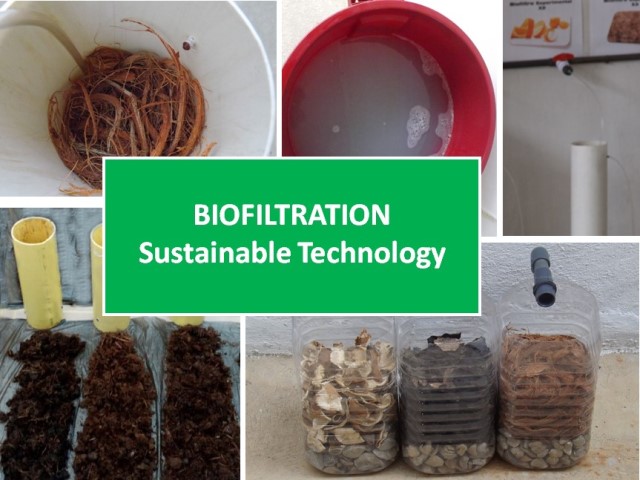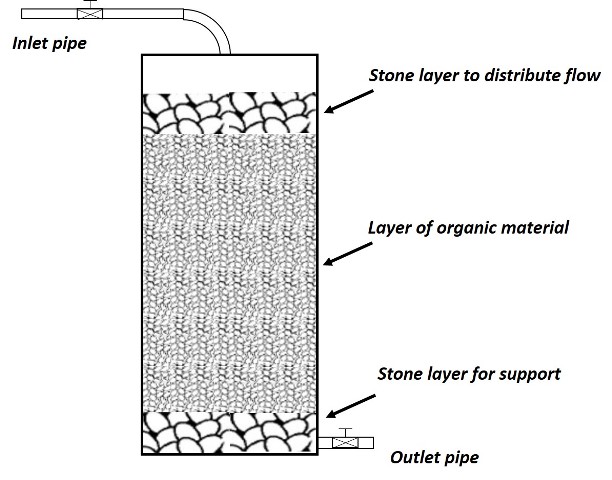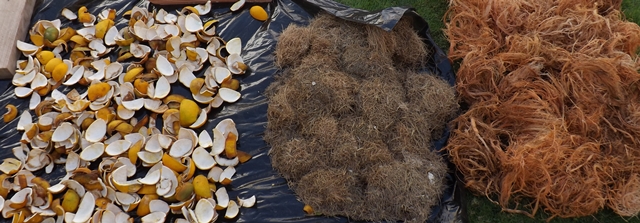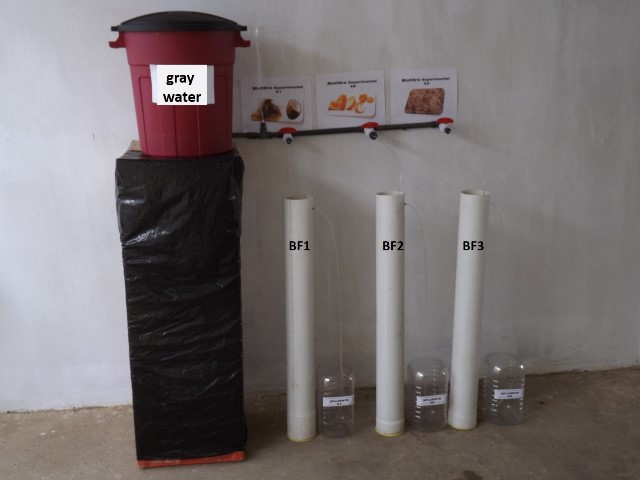Evaluation of biofiltration on organic materials, a sustainable technology
Perhaps you are aware that the excessive presence in water of organic matter and other chemical substances of inorganic nature, such as metallic ions and nutrients, constitute the main problem to be considered by the entities that control the use and disposition of effluents. That is why mitigation measures must be oriented to give a correct treatment to urban and industrial wastewater discharges into water bodies.
Unfortunately, complex water treatment operations and the high costs associated with the installation, operation and maintenance of conventional treatment systems have limited the application of these systems in rural areas, small towns and small industries. But the process of biofiltration by percolation on a filter material of organic nature is being developed in order to solve this problem and respond to the sanitation needs of these small but important socioeconomic sectors.

Source: @yusvelasquez
Introduction
The treatment of wastewater generated in isolated areas must face serious technical and economic difficulties associated with diffuse pollution, geographic dispersion and the topographic conditions of small rural communities and agro-industrial settlements. On the other hand, wastewater treatment technologies require high initial investments, constant maintenance and skilled labor for their operation.
Therefore, a logical option is to look for a residential alternative, installed in the same place of generation, which requires very little investment and is easy to install and operate. And in this, biofiltration with organic material is a great option.
The bases of this technology are very well described, reporting efficiencies in the treatment of municipal wastewater using peat as support material in the order of 90% COD, 99% BOD, 95% TSS and 99% fecal coliforms [1].
However, taking into account that the filtering material constitutes an important component of the biofilter, I proposed the evaluation of three organic materials to determine their efficiency in this type of system, giving a greater use to waste materials available in the home.
Basics of the biofiltration process on organic material
This simple technology is based on the capacity that certain organic media have to absorb different contaminating substances present in the water, in addition to favoring the proliferation of microorganisms capable of degrading organic matter into CO2, N2 and H2O[1]. The filtering medium is basically made up of organic fibers or wood shavings, and the selection of the medium as well as the configuration of the biofilter is made according to the characteristics of the effluent to be treated. The following figure shows a representation of the process.

Diagram of a vertical flow biofilter. Source: @yusvelasquez.
The wastewater fed to the biofilter circulates through the filter media and is treated by four natural mechanisms that act simultaneously: 1) slow filtration, 2) absorption, 3) biodegradation and 4) disinfection. Feed control allows a balance between growth and degradation of organic matter, leading to passive biodegradation of contaminants without the production of biological sludge. The treated water has sufficient conditions to be reused in cleaning tasks or to be discharged into any water body.
Evaluation of organic material in grey water treatment
Materials and methods
The evaluation was developed by applying three treatments using vertical flow biofilters.
The selected organic materials were orange peel, coconut fiber and dry grass.

Drying of the selected organic material. Source: @yusvelasquez.
The coconut fiber was selected because it constitutes a waste generated from the consumption of the coconut. It is very stable, with a high porosity, high capacity of retention of humidity, in addition, it has good mechanical resistance, little weight and low cost[2]. The orange peel was selected because it is an abundant waste in my town, so it is easy to acquire, and also because with this waste several studies have been conducted evaluating its ability as a bioadsorbent of metal ions because it contains cellulose, pectin, hemilcellulose and other compounds of low molecular weight and functional groups capable of binding to metal ions in solution. We also worked with dry grass, since this material is easy to acquire, handle and transport. It is generated as waste in homes, gardens as a product of pruning, and is a fibrous material with good resistance.
The experiment was carried out during 30 days, and during this time the effect of each treatment on the following variables was analyzed: organic matter, measured as Total Solids (TS), Total Suspended Solids (TSS), Biochemical Oxygen Demand (BOD) and Chemical Oxygen Demand (COD), nutrients expressed in terms of Total Nitrogen concentration and phosphates. The variables were analyzed according to the APHA-AWWA-WPCF standard methods.
The evaluation of the organic material was carried out by means of vertical filters built with a 6" diameter PVC pipe and a useful height of one meter, filling 80% of its capacity with the filtering material. The filters were fed by gravity with gray water from the washing of clothes and kitchen utensils. The tests were carried out using a hydraulic retention time of 12 hours, coming from an 80L storage tank, which also acted as a primary decanter. The disposition of the system is shown in the following image.

Experimental set-up for the evaluation of organic material. Source: @yusvelasquez.
Results
The following table shows the average initial concentrations of the evaluated contaminants in the effluent, as well as the removal percentages achieved in each treatment.

BF1: coconut fiber bed, BF2: orange peel bed, BF3: dry grass bed.
The initial characteristics of the untreated domestic effluent correspond to a wastewater of medium concentration.

Initial state and collected filtered water samples. Source: @yusvelasquez.
Effluents treated with coconut fiber and orange peel reported the best removal percentages of the evaluated contaminants. The elimination of total solids was higher than 80% in BF1, and 98.5% of suspended solids, which shows the excellent characteristics of coconut fiber for solids removal.
Regarding the organic matter, it also stands out BOD removal percentages higher than 80% with BF1 and BF2; and the COD decreased more than 60% in these treatments. The characteristics of the fiber and porosity of the coconut fiber and orange peel should positively influence the development of the biological film where the organisms that degrade the organic matter grow. Likewise, as regards the behavior of the treatments with respect to the nutrients, BF1 and BF2 achieved the best removal percentages.
Some conclusions
With these results, this evaluation shows the potential of the application of biofiltration using organic materials as a filter media for the treatment of wastewater from laundry.
Varying the height of the material, as well as monitoring the filter for a longer period until the material shows signs of no longer being effective, are additional research opportunities. Evaluating the removal efficiency of other factors such as color, turbidity and coliforms can also be investigated.
Well friends, I hope you liked the post and the information presented is useful, in another post we will design a biofilter.
References
[1]. Garzón-Zúñiga, M., Buelna, G.,Moeller-Chávez, G.(2012). Biofiltration on organic media, a new sustainable technology for wastewater treatment in small communities and industries. Tecnología y Ciencias del Agua Article online (3), 153-161.
[2]. Fernández, E. y Sánchez, K. (2016). Evaluación de un lecho filtrante, utilizando mesocarpo de coco (cocos nucífera), para el tratamiento de aguas residuales de la empacadora de banano algarrobo 1, Sullana 2015 [Online thesis]. Universidad Señor de Sipán.
[3]. García, S. (2007). Decoloración Fúngica de efluentes industriales con colorantes azo en sistemas de biofiltración con diferentes empaques orgánicos[Tesis en línea]. Universidad Nacional Autónoma de México.
Thanks for your contribution to the STEMsocial community. Feel free to join us on discord to get to know the rest of us!
Please consider supporting our funding proposal, approving our witness (@stem.witness) or delegating to the @stemsocial account (for some ROI).
Please consider using the STEMsocial app app and including @stemsocial as a beneficiary to get a stronger support.
Thank you very much for your support friends!
Excellent work, congratulations.